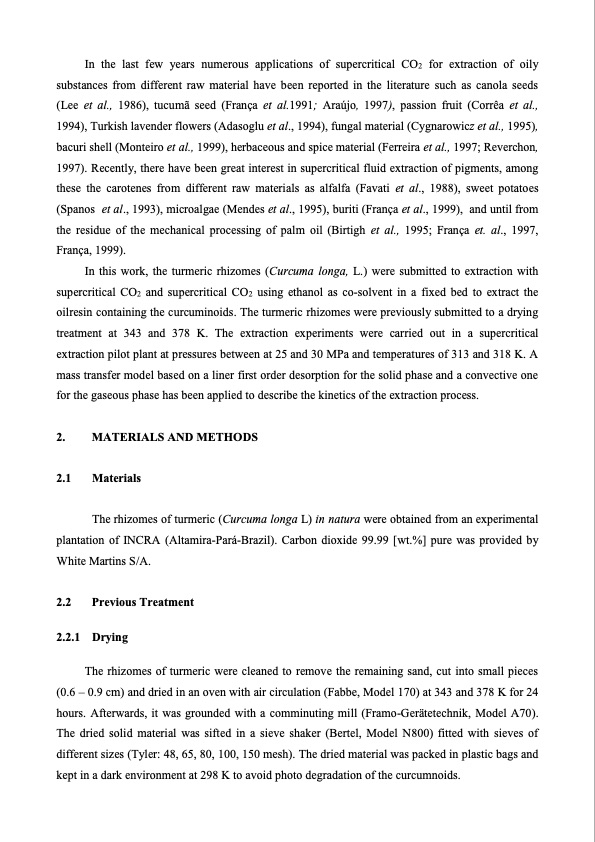
PDF Publication Title:
Text from PDF Page: 004
In the last few years numerous applications of supercritical CO2 for extraction of oily substances from different raw material have been reported in the literature such as canola seeds (Lee et al., 1986), tucumã seed (França et al.1991; Araújo, 1997), passion fruit (Corrêa et al., 1994), Turkish lavender flowers (Adasoglu et al., 1994), fungal material (Cygnarowicz et al., 1995), bacuri shell (Monteiro et al., 1999), herbaceous and spice material (Ferreira et al., 1997; Reverchon, 1997). Recently, there have been great interest in supercritical fluid extraction of pigments, among these the carotenes from different raw materials as alfalfa (Favati et al., 1988), sweet potatoes (Spanos et al., 1993), microalgae (Mendes et al., 1995), buriti (França et al., 1999), and until from the residue of the mechanical processing of palm oil (Birtigh et al., 1995; França et. al., 1997, França, 1999). In this work, the turmeric rhizomes (Curcuma longa, L.) were submitted to extraction with supercritical CO2 and supercritical CO2 using ethanol as co-solvent in a fixed bed to extract the oilresin containing the curcuminoids. The turmeric rhizomes were previously submitted to a drying treatment at 343 and 378 K. The extraction experiments were carried out in a supercritical extraction pilot plant at pressures between at 25 and 30 MPa and temperatures of 313 and 318 K. A mass transfer model based on a liner first order desorption for the solid phase and a convective one for the gaseous phase has been applied to describe the kinetics of the extraction process. 2. MATERIALS AND METHODS 2.1 Materials The rhizomes of turmeric (Curcuma longa L) in natura were obtained from an experimental plantation of INCRA (Altamira-Pará-Brazil). Carbon dioxide 99.99 [wt.%] pure was provided by White Martins S/A. 2.2 Previous Treatment 2.2.1 Drying The rhizomes of turmeric were cleaned to remove the remaining sand, cut into small pieces (0.6 – 0.9 cm) and dried in an oven with air circulation (Fabbe, Model 170) at 343 and 378 K for 24 hours. Afterwards, it was grounded with a comminuting mill (Framo-Gerätetechnik, Model A70). The dried solid material was sifted in a sieve shaker (Bertel, Model N800) fitted with sieves of different sizes (Tyler: 48, 65, 80, 100, 150 mesh). The dried material was packed in plastic bags and kept in a dark environment at 298 K to avoid photo degradation of the curcumnoids.PDF Image | SUPERCRITICAL CO2 EXTRACTION OF CURCUMINS

PDF Search Title:
SUPERCRITICAL CO2 EXTRACTION OF CURCUMINSOriginal File Name Searched:
ISSF2000-012015_06_1705_07_37UTC.pdfDIY PDF Search: Google It | Yahoo | Bing
CO2 Organic Rankine Cycle Experimenter Platform The supercritical CO2 phase change system is both a heat pump and organic rankine cycle which can be used for those purposes and as a supercritical extractor for advanced subcritical and supercritical extraction technology. Uses include producing nanoparticles, precious metal CO2 extraction, lithium battery recycling, and other applications... More Info
Heat Pumps CO2 ORC Heat Pump System Platform More Info
| CONTACT TEL: 608-238-6001 Email: greg@infinityturbine.com | RSS | AMP |